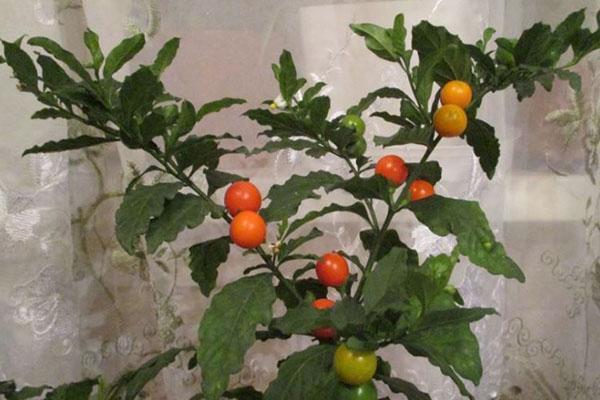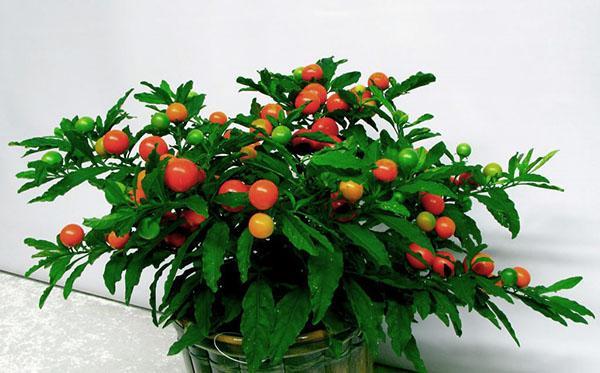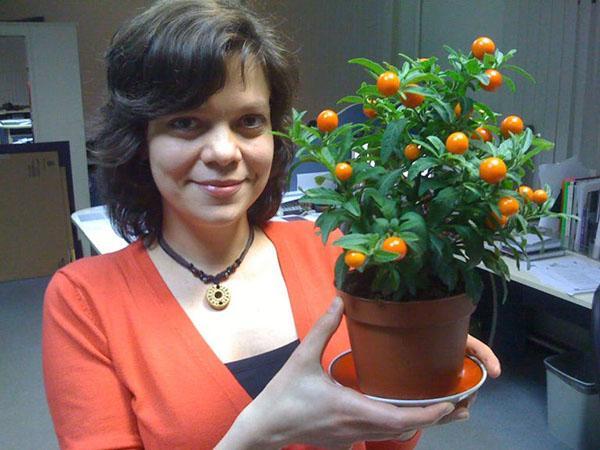Berry mosaic on the window - indoor nightshade
 An amazing plant with which you can create an exotic green corner is indoor nightshade. Its main decoration is fruits. It is they who give the bush a chic and elegant look. The appearance of berries among rich greenery resembles a spruce, decorated with bright balls. Why not give yourself such a cute flower and admire its beauty? Let's take a closer look at the exquisite berry mosaic on the window.
An amazing plant with which you can create an exotic green corner is indoor nightshade. Its main decoration is fruits. It is they who give the bush a chic and elegant look. The appearance of berries among rich greenery resembles a spruce, decorated with bright balls. Why not give yourself such a cute flower and admire its beauty? Let's take a closer look at the exquisite berry mosaic on the window.
Indoor nightshade: the secret of the attractiveness of the plant

 The flower grows to about 30 cm. From the side it resembles a small bush. The oblong lanceolate foliage has a rich dark green color, against which clearly pronounced veins are visible. The edges of the plates are distinguished by a wavy frame, which gives the bush a spectacular look.
The flower grows to about 30 cm. From the side it resembles a small bush. The oblong lanceolate foliage has a rich dark green color, against which clearly pronounced veins are visible. The edges of the plates are distinguished by a wavy frame, which gives the bush a spectacular look.
 During the flowering period, buds appear on the branches of the indoor nightshade. They can grow in inflorescences in several pieces or singly. It is interesting that flowering takes place at different times of the warm season, but the berries appear in the winter. Their size is about 1.5 cm. Ripe color can be from bright red to orange. From the outside it looks very nice. Against the background of dark green leaves, scarlet beads shine with bright lights, which hold on to the shoots for several months. They do not fade or fall off.
During the flowering period, buds appear on the branches of the indoor nightshade. They can grow in inflorescences in several pieces or singly. It is interesting that flowering takes place at different times of the warm season, but the berries appear in the winter. Their size is about 1.5 cm. Ripe color can be from bright red to orange. From the outside it looks very nice. Against the background of dark green leaves, scarlet beads shine with bright lights, which hold on to the shoots for several months. They do not fade or fall off.
Among the popular varieties of plants, the decorative indoor nightshade "Three-flowered" is especially appreciated. During the fruiting period, brushes of homogeneous berries appear on the branches, which are the decoration of the living quarters.
Simple rules for growing berry mosaic at home
 Growing culture on your windowsill is easy. She feels great in a variety of soil. The main condition is that the soil must be loose. Often, fans of home crops grow indoor nightshade from seeds, carefully observing its development. The process begins in late May or early June.
Growing culture on your windowsill is easy. She feels great in a variety of soil. The main condition is that the soil must be loose. Often, fans of home crops grow indoor nightshade from seeds, carefully observing its development. The process begins in late May or early June.
 Place the seeds evenly in small containers filled with suitable soil. Then they are covered with a layer of sand of about 1 cm and irrigated with a spray bottle. The containers are covered with plastic wrap and placed in a room where the temperature is at least 22 ° C. It should also have a lot of daylight. The first seedlings will turn green on the ground in about 14 days. When they get stronger, and there will be 3 leaves on the shoots, the sprouts dive into other containers.
Place the seeds evenly in small containers filled with suitable soil. Then they are covered with a layer of sand of about 1 cm and irrigated with a spray bottle. The containers are covered with plastic wrap and placed in a room where the temperature is at least 22 ° C. It should also have a lot of daylight. The first seedlings will turn green on the ground in about 14 days. When they get stronger, and there will be 3 leaves on the shoots, the sprouts dive into other containers.  After 30 days, the grown seedlings are transplanted again, but already to a permanent habitat.
After 30 days, the grown seedlings are transplanted again, but already to a permanent habitat.
The last dive is carried out when the nightshade bushes grow up to 15 cm in height.
When the plant takes root, you need to know the rules of how to cut the nightshade and not harm it. The procedure is performed several times a year. In late February or early March, all shoots of the culture are shortened by a third of the main length. This is best done during the ripening period of all berries, and when the foliage turns yellow.
For the effective formation of the indoor nightshade bush, additional pruning is carried out in April or early May.The procedure is repeated before blooming buds. To increase the bushiness of the culture in the fall, new shoots are pinched to the branches where there are no buds and fruit ovaries. As a result, a cute decorative ornament, strewn with bright fruits, will appear on the windowsill.
A smart approach to caring for indoor nightshade
 Since the plant came to Europe from tropical countries, the conditions for its maintenance must correspond to its natural habitat. A sensible approach to caring for indoor nightshade at home leads to a remarkable result. Exotic berries will become an exquisite decoration of the living space, turning it into an oasis of peace and pleasure.
Since the plant came to Europe from tropical countries, the conditions for its maintenance must correspond to its natural habitat. A sensible approach to caring for indoor nightshade at home leads to a remarkable result. Exotic berries will become an exquisite decoration of the living space, turning it into an oasis of peace and pleasure.
The basic rules of care are to create suitable conditions for the culture, which include:
- lighting;
- humidity;
- temperature regime;
- watering;
- top dressing.
Let's consider in detail each procedure to grow an exotic flower at home.
Enough light
 Practice shows that the right lighting directly affects the decorativeness of nightshade. Throughout the season, the plant needs diffused light. Therefore, it is placed on windows facing east or west. When winter comes, the flower feels wonderful on the south side. With insufficient light, nightshade develops poorly and bears a small amount of fruit.
Practice shows that the right lighting directly affects the decorativeness of nightshade. Throughout the season, the plant needs diffused light. Therefore, it is placed on windows facing east or west. When winter comes, the flower feels wonderful on the south side. With insufficient light, nightshade develops poorly and bears a small amount of fruit.
Reasonable temperature and humidity control
 For the successful development of a tropical plant indoors, it is necessary to maintain an optimal temperature regime. In spring and summer, it is in the range from 18 to 25 ° C, and in winter 12 or 15 ° C is allowed. If the temperature regime is violated, the flower will lose all berries and foliage. This is one of the reasons why nightshade leaves fall at the most inopportune moment.
For the successful development of a tropical plant indoors, it is necessary to maintain an optimal temperature regime. In spring and summer, it is in the range from 18 to 25 ° C, and in winter 12 or 15 ° C is allowed. If the temperature regime is violated, the flower will lose all berries and foliage. This is one of the reasons why nightshade leaves fall at the most inopportune moment.
The plant does not like drafts, therefore, when airing the room, it is better to remove the culture pots to another place.
Since nightshade is native to the tropics, it needs regular spraying. Also, the pot with the culture can be placed in a shallow pan with moistened drainage material. The main thing is that there is no direct contact with water. Insufficient air humidity has a detrimental effect on the development of culture. Therefore, gradually losing vitality, nightshade dries up and may eventually die.
A wise approach to watering
 During intensive development, in spring and summer, the plant especially needs moisture. As soon as the topsoil dries up, and this happens quite quickly, it must be watered immediately. With the onset of autumn, and then winter, the amount of watering is reduced. As a result, the bush will always decorate the living space.
During intensive development, in spring and summer, the plant especially needs moisture. As soon as the topsoil dries up, and this happens quite quickly, it must be watered immediately. With the onset of autumn, and then winter, the amount of watering is reduced. As a result, the bush will always decorate the living space.
For irrigation, it is advisable to use settled water at about room temperature.
Reliable beauty stimulant - top dressing
 If a person stops eating, the first thing from his face is beauty. Likewise, a tropical guest cannot bear fruit abundantly without feeding. For feeding, you can use liquid fertilizers complex nature. They are brought in once every 14 days during the period of fruit formation or vegetation. After the formation of berries, top dressing is applied once a month.
If a person stops eating, the first thing from his face is beauty. Likewise, a tropical guest cannot bear fruit abundantly without feeding. For feeding, you can use liquid fertilizers complex nature. They are brought in once every 14 days during the period of fruit formation or vegetation. After the formation of berries, top dressing is applied once a month.
Invisible enemies of the tropical beauty

Exquisite sheet plates of indoor nightshade attract the attention of pests:
- whitefly;
- red spider mite;
- orange aphid.
Often insects settle on them, reproduce and suck out juices. The plant begins to ache and lose its decorative effect.
The miniature whitefly, which slightly resembles a moth, loves to feast on the juice of the culture. It leaves sugary traces on the leaves, and larval clutches on the back of the plate. If everything is left to chance, the leaves will begin to curl, turn yellow and eventually fall off.
Another "uninvited guest" of the flower - spider mite... Its favorite habitats are the back of the leaf plate.Pest-caused diseases of the indoor nightshade are manifested in the formation of miniature specks on the foliage. Over time, they turn into spots that spread throughout the culture.
Similarly, the plant infects orange aphids. It settles on the back of the plates that grow on the tops of the shoots. As a result, the foliage turns yellow and dries over time. To stop the process of crop disease, you need to get rid of pests with the help of special preparations. And then the indoor nightshade will delight the owners with its lush greenery and bright berries all year round.